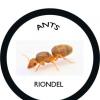I've search quite a bit for basic information on Monomorium Minimum with very little success. So i'm intending for this topic to be a location where people that have reared that species to post what they've observed.
Basic info:
Hibernation: Yes they hibernate. Not sure if they need it. Temperatures around 13C seem to be cold enough. I kept two colonies at around 12-13C and they were fine.
Nuptial flight: Possibly June- July in central kansas i caught all of mine in the act of mating between June 23 -june 7. There is a wiki source that says that nuptial flights have not been observed. I have never seen them mate in flight but i have found them mating in locations high off the ground so i'm thinking if they don't mate in flight they do disperse by flying than mate on the ground. 06/05/2020 update i have seen on two occasion a male fly toward a female perched in a high location and mate with her at that location. This to me suggest that mating DOES NOT happen in flight.
Queens: Polygynous - antwiki mentions up to 12-14 queens living together.
Claustral: Fully claustral - I got this info from fellow member YsTheant, also all five of my separately raised queens turned out fine.
Life cycle: egg -pupae ~10-13 days, egg-adult: ~32-35 days , not really sure on the temperature, but the ambient temperature of my house was about 80 F so i'm thinking the drawer i kept them in was in the 70's F.
Hibernation: Yes, not sure what the ideal temperature is
Longevity of queen: There is source out there that says " queen lives approximately year in captivity" i cannot confirm this. I'll let you know by this time next year.
Nest location: According to various members: Sandy or loamy soil in open dry areas, under rocks, under bark and logs, near drain ditches.
I've seen many colonies in soil with very little vegetation nearby (not sure what type of soil yet). A wiki source states that the nest is about 10cm down in the soil.
Pupae: does not form a cocoon.
foods: honey, fruit flies, Silkworm and sunburst ant nectar (from member JonhTX)
Behavior: The queen and the male can remain attached for a while, i have seen the queen drag the male around for a while. She also does this weird thing where it seems like she is nibbling his butt; it doesn't seem to damage him though. It seems to me that for them to detach they both have to get a good grip on the surface and move in opposite directions. After mating the queen will remove her wings using her back legs, this can take from a few minutes to a few hours.
Antwiki link: http://www.antwiki.o...omorium_minimum
I will add more info as i get them.
Edited by Nanos, June 5 2020 - 6:46 PM.
































